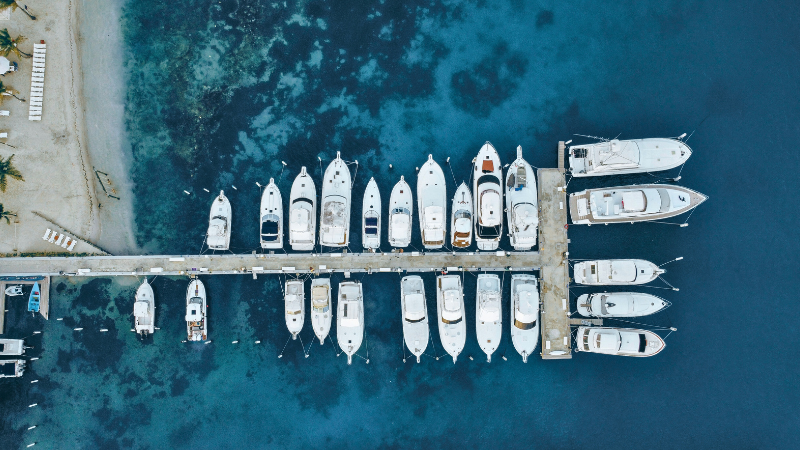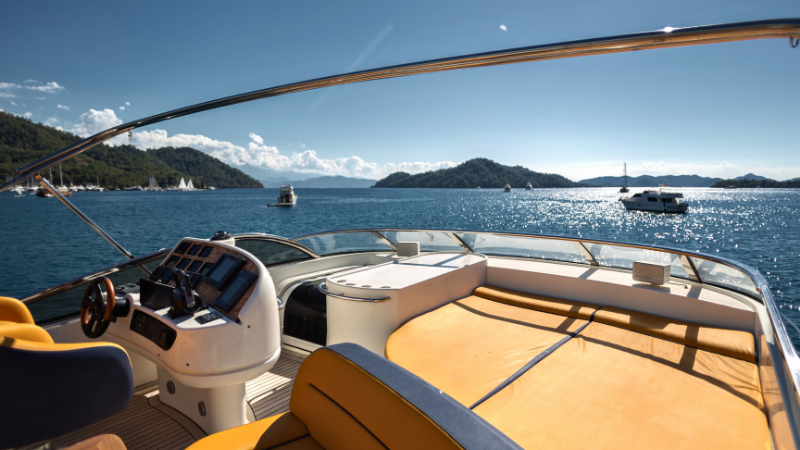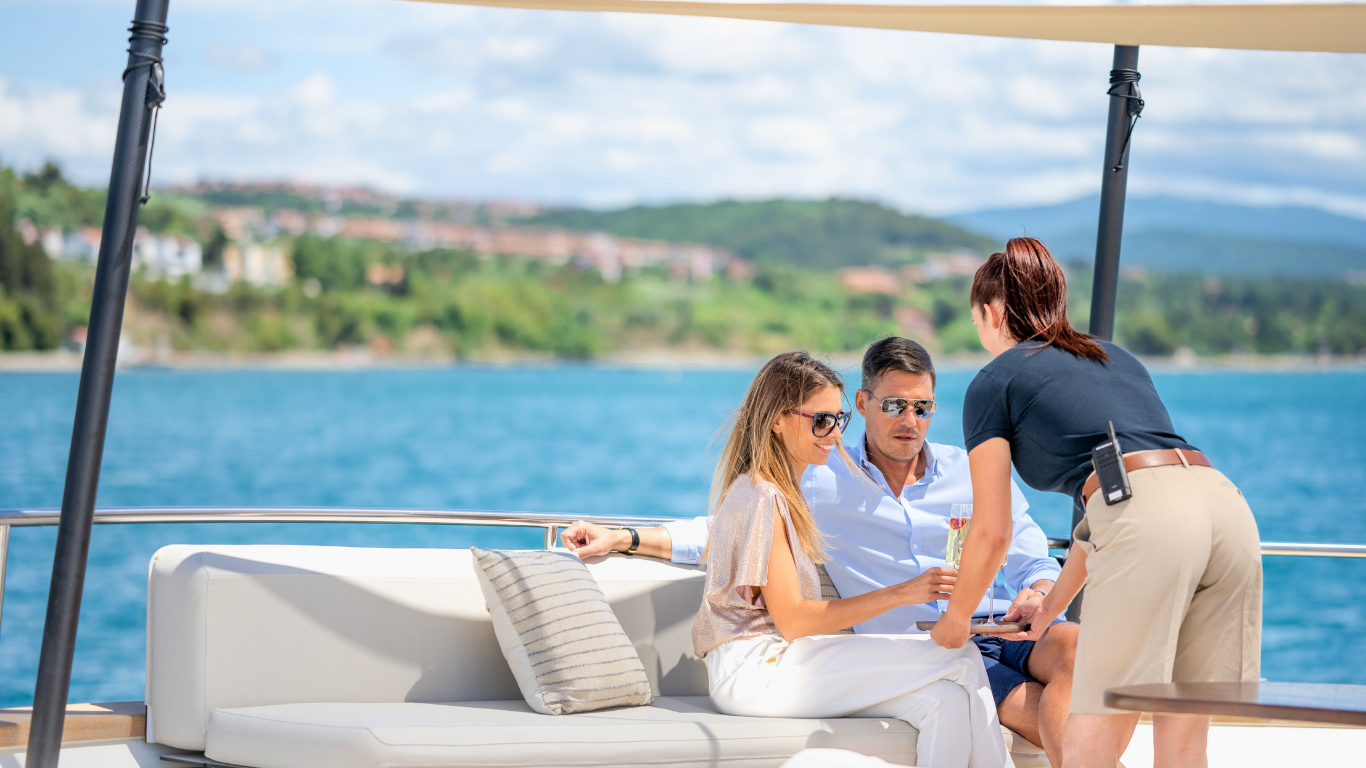
- On July 23, 2025
- Amri Van Aswegen
The artistry of yacht selection
Chartering a yacht isn’t just a booking, it’s the start of something personal. It’s your space, your pace, and your experience. And for travelers used to standards, the real work starts long before you step onboard.
Choosing a yacht to charter means thinking through what matters most, comfort, flexibility, privacy, and the kind of journey you want to have. It's not about picking the fanciest boat. It's about what fits.
Let’s take a look at what you need to know before choosing a yacht to charter.
1. Defining your vision: type, purpose & who you're traveling with
What kind of trip are you planning? A quiet getaway? A business charter? A family escape? Every yacht tells a different story, and you’ll want one that matches yours.
A few things to consider:
Luxury yacht rentals with full crews are ideal if service is a priority. Think onboard chefs, daily housekeeping, and someone to handle every detail.
Private yacht hire is usually smaller, a bit more personal, and better for couples or close-knit groups.
Motor yachts are popular for speed and space. They're good for covering a lot of ground, or sea, without sacrificing comfort.
Sailing yachts lean toward a slower, more classic experience. If you enjoy the motion of the ocean, this could be it.
Corporate yacht charters need more than just good Wi‑Fi. Look for conference-ready spaces, solid privacy, and quiet, tech-equipped cabins.
If you’re traveling with family, especially with kids or older guests, the layout matters. Look at yacht charter reviews for feedback on how different boats handle real-life family dynamics. Read more about family yacht charters here.
The clearer you are on your goals, the easier it is to narrow down your yacht charter options.
2. Mapping your voyage: destinations & sailing routes
Not all waters are created equal. Some regions are made for slow exploring, others for fast cruising. And depending on the season, a great charter location in June might be a no-go in November.
Some popular yacht charter locations include:
The Mediterranean: French Riviera, Amalfi Coast, and Greek Isles are favorites for good reason: scenery, food, and easy cruising.
The Caribbean: The Bahamas and BVI are built for island hopping, especially in winter months.
More remote areas like French Polynesia offer fewer ports, but more privacy.
Your sailing route depends on where you go, but also on what you want. Long, uninterrupted stretches? Short hops between islands? Dockside dinners or off-grid silence? Captains can usually tweak the plan around your style.
Certain places also pair better with certain boats. If you're navigating breezy island chains like the Cyclades, a sailing catamaran is a smart pick. Heading to St. Barts in a tight time frame? You’ll want a fast motor yacht.
3. Yacht type comparison & choosing the right size
The right yacht isn’t always the biggest; it’s the one that fits your needs. How many people are joining? How much space do you want? What extras matter?
Here’s a general breakdown:
30–50 ft (Express yachts): Great for couples or quick charters. You’ll trade space for agility.
50–80 ft (Flybridge motor yachts): More room, better decks, and often a few crew members.
80 ft and up (Superyachts): Where you’ll find beach clubs, spas, gyms—even helipads on some.
With every jump in size, you’ll get better guest-to-crew ratios and more advanced onboard amenities. But you’ll also need to think about where the yacht can go. Some ports aren’t made for deeper drafts.
Size matters, but so does function. A well-designed 60-footer can feel more livable than a cluttered 90-footer. That’s where layout and experience come in.

4. Onboard amenities: details that make the difference
This is where many yachts separate themselves. You’re not just renting transport, you’re choosing how you’ll spend your days.
Features you’ll often find on luxury charters:
Wellness-focused setups: Spa rooms, Jacuzzis, workout areas, and even yoga decks
Toys and gear: Jet skis, seabobs, paddleboards, kayaks, snorkels, scuba gear
Tech and entertainment: Streaming services, cinema rooms, high-speed Wi‑Fi
Leisure spaces: Beach clubs, shaded sunbeds, lounges built for lazy afternoons
Not every yacht will have everything, but most offer more than you’d expect. If you have specific needs (a massage therapist, dive instructor, or child-friendly gear), bring it up early.
5. The chartering process: what to expect before you board
Booking a yacht has a rhythm to it. If you're working with a broker or concierge service, they’ll walk you through it, but it helps to know the steps.
The process usually looks like this:
Inquiry: Pick your travel dates, group size, and general preferences.
Proposals: You’ll get a few yacht charter options that match your request, including photos, layouts, and rates.
Optioning: You can place a soft hold on your preferred yacht, usually for 48–72 hours, while you decide.
Contract & deposit: Once you’re ready, you’ll sign the agreement and pay 30–50% of the charter fee. A refundable security deposit is also standard (often 5–10%).
Planning phase: You'll be asked for food preferences, medical notes, excursion interests, and anything else your crew should know.
Boarding day: You’ll be welcomed aboard by the captain, get a quick rundown of the yacht, review your itinerary, and then you’re off.
The chartering process is smooth when handled right. Good brokers simplify it, and good crews prepare for everything before you even arrive.
6. Budgeting smartly without compromising luxury
A chartered yacht is a floating sanctuary, but understanding the costs ensures your serenity starts long before you set sail.
Understand what’s included (and what’s not):
Base charter rate: This usually covers the yacht, the crew, and basic amenities.
APA (Advance Provisioning Allowance): Roughly 30–35% of your base rate. The APA handles fuel, food, dockage, port taxes, and onboard preferences like rare wines or organic produce. The captain manages it, and a full expense report is typically shared at the end of your trip.
VAT or local taxes: For example, charters departing from Italy may incur a 22% VAT. Caribbean islands often charge duty fees per guest.
Crew gratuity: This is customary in the industry, generally 10–20% of the base rate. Discreet, envelope-style tipping is common at the end of your charter.
Pro tip: Choose a transparent charter broker who explains every charge upfront. Luxury doesn’t mean surprises, unless they’re champagne on the bow.
7. What reviews can tell you
Yachts are easy to market. They photograph well. Reviews show you what they’re like in motion, with real people onboard.
Look beyond the stars. Read what past guests say about the crew, the food, the flexibility, and how issues (if any) were handled. If a yacht keeps coming up in yacht charter reviews with the same crew mentioned by name, that’s a good sign.
Families, corporate groups, honeymooners, they all have different needs. Try to find feedback that reflects your trip type. And don’t just skim for praise. How people describe the onboard amenities, downtime, and overall flow gives you more useful insight than glowing summaries.
8. Yacht charter brokers vs. direct companies: What’s best for you?
When you're choosing a yacht to charter, one of the first decisions you'll face is whether to go through a broker or book directly with a charter company. On the surface, both get you a yacht—but the experience is very different.
A good broker isn’t just there to make a booking. They’re connected. They know the captains, they’ve toured the boats, and they understand how to pair the right client with the right crew. They’ll walk you through every detail, from selecting the best yacht for your needs to handling the paperwork, negotiations, and any surprises along the way.
Working with a broker means:
You’re not limited to one company’s fleet; you can access yachts across the global market.
They’ll know the boats with the best reputations, crews with real experience, and which vessels have the onboard amenities you’ll actually care about.
They can often negotiate better pricing, more flexible terms, and extras that don’t come standard.
If something goes wrong, they’re the ones fixing it, not you.
Booking directly with a yacht company isn’t wrong if you already know exactly what you want. But it does limit you to their fleet, their rates, and their conditions. There’s no room for comparison, and no one is advocating for you behind the scenes.
That’s why most luxury travelers use brokers. It’s faster, safer, and you get access to yacht charter options you might never find on your own.
9. Routes, timing, and how flexible things really are
One of the biggest advantages of private yacht hire is how much flexibility you have. Your charter doesn’t come with a locked-in schedule unless you want one. Some guests show up with a detailed plan. Others prefer to decide day by day, based on weather, mood, or simply where the water looks bluest.
It’s completely up to you.
That said, timing and location do matter, especially if you're trying to avoid crowds or chase ideal conditions.
In the Mediterranean, June to August is the busiest stretch. The days are hot, the water’s perfect, but popular ports can be packed.
In the Caribbean, December through April is prime time. Expect calm seas, warm breezes, and fewer storms.
Some guests plan their trips around major events, like Antigua Sailing Week, Cannes Film Festival, or summer festivals in Capri or Amalfi. These weeks book up quickly, so if you're chartering around a specific event, timing is everything.
The best sailing routes aren’t always the obvious ones. A good captain can reroute to dodge a storm or swap in a quiet bay when a harbor’s too full. That’s the beauty of private travel, it bends with you.
10. Safety protocols and maritime professionalism
With luxury yacht rentals, comfort is expected. But safety should always come first. That means ensuring the yacht, and the crew, meet global safety standards before you ever step on board.
It’s not dramatic. It’s just smart.
Here’s what should be in place on any serious charter:
All crew should be STCW-certified, which covers fire safety, emergency procedures, and medical basics.
For larger vessels, look for SOLAS compliance, it means the yacht meets strict international safety requirements.
The yacht should have up-to-date maintenance records and full insurance coverage.
Emergency equipment like flares, life vests, EPIRBs, and defibrillators should be onboard, along with a well-equipped tender that can double as a rescue vessel.
At least a few crew members should be trained in CPR and emergency care.
Want a simple way to tell if a charter takes safety seriously? Ask if they run a safety briefing when you board. Top-tier yachts always do. It sets the tone, keeps everyone informed, and shows you’re in capable hands from day one.

11. Eco-luxury is the new luxury
Sustainable yachting isn’t just a trend, it’s the future. Today’s top-tier yachts are embracing eco-conscious innovations without sacrificing elegance.
Features of green yachts to look for:
Hybrid propulsion systems that reduce fuel consumption and noise.
Solar panels and battery banks for sustainable energy at anchor.
Advanced waste management that minimizes ocean impact.
Use of reef-safe sunscreens, biodegradable cleaning products, and water makers.
You can also do your part:
Support local businesses and guides at each port.
Avoid single-use plastics onboard.
Choose destinations with active marine conservation programs, like the Exumas Land and Sea Park or Sardinia’s Maddalena Archipelago.
Eco-friendly sailing isn’t about sacrificing luxury. Done right, it makes the whole experience quieter, smoother, and better for the water you're in.
12. Final prep: What to confirm before you board
A lot happens before you ever see the boat. The best trips are the ones where no one’s scrambling at the last minute.
Your pre-departure list should include:
A signed contract and full invoice history
Final itinerary and cruising plan
Food and beverage preferences (and allergy notes)
Excursion wish list, private diving, chef’s table dinners, local guides
Arrival logistics, whether you're flying, driving, or landing by chopper
Communication setup, Wi‑Fi, satellite, VOIP, or otherwise
Once that’s squared away, you’re ready. From there, it’s just you, the water, and a crew that already knows how to make it all work.
Choosing your yacht
The perfect yacht charter isn’t about size or style, it’s about synchronicity. When vessel, crew, route, and guest preferences align, the experience transcends the ordinary.
Choosing a yacht to charter means selecting how you want to feel every hour of your voyage: pampered, private, empowered, relaxed. It’s your week, your sea, your sky, make it exquisite.

